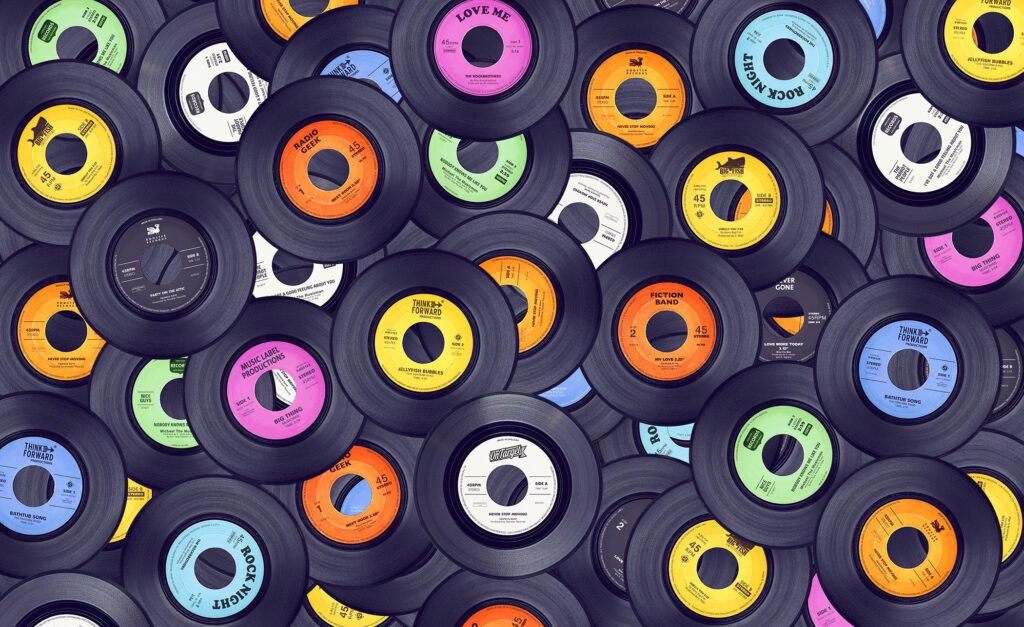
Every year, between Memorial Day and Labor Day, pop culture prognosticators playfully bicker over their candidates for The Song of the Summer. But there’s an equally enjoyable argument to be made over The Sip of the Summer: That cool boozy concoction that seems to show up at every barbecue and beach bash, somehow simultaneously novel and ubiquitous.
Back in 1985, the dancing/drinking duo de rigeur was Prince’s Raspberry Beret washed down with wine coolers. While summer 1993’s Whoomp! There It Is (by Tag Team) proved to have about as much staying power as the same season’s Zima, the late ‘90s saw three-peat inebriator the Cosmopolitan continually quaffed with Waterfalls (TLC, 1995), The Macarena (Los Del Rio, 1996) and Fly (Sugar Ray, 1997).
More recently, in 2019, America raised cool, calculated hard seltzers to Megan Thee Stallion and her similarly market-calibrated Hot Girl Summer. In 2020 we had Don’t Start Now (Dua Lipa) and, by default, Corona.
This year Doja Cat’s Kiss Me More and Justin Bieber’s Peaches are battling to be the season’s aural oral fixation. And—in this observer’s opinion—the Sip of the Summer has become The Slurp of the Summer, with boozy squeezy freeze pops topping poolside popularity charts.
In their honor, we present ‘Alcopops: Behind the Music’, complete with its own summery pop soundtrack.

Origin Story (Popsicles & Icicles)
Back in the Cosmopolitan era, Chris Claffey was hanging out with college friends at the Jersey Shore when he first started thinking about alcoholic ice pops. (The word Popsicle® is the trademarked intellectual property of the Unilever company and thus—except in quotations— this essay’s Voldemort).
“We were drinking, we were eating freeze pops,” Claffey recalls. “And it just seemed like a no-brainer. Like the old Reese’s ‘you’ve got your peanut butter in my chocolate’ thing. Wouldn’t it be great to combine the two?”
Alas, the full-brainer called Life intervened. Claffey the college student became Claffey the mortgage broker and family man in Collegeville, Pennsylvania. But the concept never left his mind and in 2011, with a modicum of business success under his belt, Claffey revisited the notion as a side gig, taking a home equity loan and beginning to experiment.” The eventual results proved a rousing success: Introduced in 2014, the trendsetting Claffey’s Frozen Cocktails (cocktail not being a legal term, they are actually made from a wine base) now sell over 300,000 cases a year at retailers in 42 states and online.
As Claffey and the entrepreneurs behind several later entries to the alcopop category discovered, this is a market segment that poses several significant challenges, chief among them formulation and packaging. Yet what one might assume would be the biggest barrier—paranoid parents’ organizations—has been significantly less daunting than might be expected.
“I realize the concept has a nostalgic appeal for adults,” says Claffey, “But I have four kids. I never wanted there to be any confusion about who these were for. That’s why the name includes the word “cocktails”—which should be a signal to anyone that this product is not for children.” Putting his own name on the product further underscored Claffey’s commitment to ethical entrepreneurship.
Frankly, a taste testing of Claffey’s Frozen Cocktails—along with a sampling of the dozens of other booze pop brands that have come to market since—makes it quite clear that this is not kids’ stuff: The flavor profile of these products is distinctly alcoholic, with wine, malt beverages or hard liquor evident from the first lick or nibble. You’ve likely had a frozen daiquiri or other parasol-garnished cocktail that tasted significantly sweeter.

Pop paranoia ( Cold As Ice )
The booze-forward taste of alcopops was a smart preemptive move for Claffey and other manufacturers who realized that the product’s form-factor might attract the attention of conservative rabble-rousers. And while there has been some pushback on that front, its been largely of the speculative evidence-free variety:
Last summer, in Psychology Today magazine, Dr. Judith Wurtman, who has worked at Harvard and MIT, wrote that “Popsicles containing alcohol seem to be the alcoholic equivalent of fruit and candy-flavored e-cigarettes…” and provocatively stated “An alcopop is not just a popsicle. It is a tasty vehicle for delivering a substance to those who at a very young age might develop a lifetime craving for more.” This June, clickbait online publication Mandatory, published a more blatantly sensationalist article headlined: “Bud Light Seltzer Popsicles Makes Keeping Kids Sober the New Summer Challenge, Missed Opportunity Not Calling Them ‘Pedophile Pops’.”
The very fact that, starting in 2020, Bud’s risk-averse corporate parent, Anheuser Busch, grabbed the coattails of smaller pioneers to aggressively entered the alcopop category with the launch of Freeze-A-Rita frozen margarita icicles(margarita not being a legal term, they contain no tequila, just “malt beverage”) suggests that conservative “Save The Children” warnings proved largely unconvincing and that the products have broad appeal and acceptance among responsible, law-abiding adults.
Grown Up-sicles (Pop Muzik)
“Being able to taste the liquor in our product was essential,” explains Bronya Shillo, whose family’s Long Island-based company introduced Fishers Island Lemonade Frozen Spirit Pops this past spring. Made with vodka, a 6-month barrel aged rye/bourbon whiskey blend and honey as a sweetener, the pops—like the canned cocktail that shares their name and has been sold since 2014— are specifically blended to match the flavor of the house cocktail made famous at the family-owned Pequot Inn on Long Island Sound. “The only way a new SKU is credible for us is if it tastes like the drink people know.” In fact, Shillo hopes that, for consumers who try them as a novelty, the freeze pops will serve as a gateway to her flagship canned product.
Like Fishers Island pops, Fabrizia Frozen Cocktails are third generation descendents of their progenitor beverage. In 2008, brothers Phil and Nick Mastroianni founded New Hampshire-based Fabrizia Spirits, now the largest U.S. manufacturer of limoncello. Since the only part of a lemon used in making limoncello is the rind, the brothers eventually decided to utilize the remainder of their fruit to make a canned Italian margarita, blending the fresh lemon juice with their limoncello and tequila and, after its successful launch in 2018, several other canned limoncello cocktails. Their move into freeze pops this year came at the urging of Mino Songhomonian, General Sales Manager at Massachusetts’ Atlantic Beverage Distributors, who tipped the Mastroiannis off to the boom and suggested that their cocktails’ flavor profile would make a natural fit. Of all the brands tasted in assembling this article, the Fabrizia pops were the most blatantly boozy.

Manufacturing challenges(Popsicle)
The portability, convenience and lack of shatter-prone glass shared by alcopops and canned liquor also made boozy pops a natural line extension for Cutwater Spirits, a leading canned cocktail manufacturer. The San Diego-based company was already well into the development of its alcopop line when they were acquired by Anheuser Busch in 2019. In fact, says Gwen Conley, Cutwater’s Director of Quality & Innovation, “We had a year under our belt with the pops before Freeze-A-Ritas went on the market and I got a real kick out of having people from corporate calling us to see how we were doing things.”
Today’s booze-infused freeze pops are manufactured similarly to old school Otter Pops and Fla-Vor-Ice. They’re packaged in narrow plastic sleeves, shipped to retail in shelf-stable liquid form, then frozen at home by consumers. The single-serve pouches begin as a sort of giant plastic chitlin. As this lengthy tube is filled with liquid, heated blades effectively cauterize it into individual pop-size segments.
But alcohol makes everything a little bit different, and all of the Mom & Pop pop-makers acknowledge early struggles with leakage—a major objection point for retailers and distributors. “We import a half million lemons from Sicily a year,” says Phil Mastroanni of Fabrizia.“That’s a cake walk compared to getting a frozen pop machine to work efficiently.”

Fizz, freezing and physics (Lick It Up)
Even with packaging issues ironed out, the formulation of every new flavor poses its own challenges for those brands which are trying to mimic the taste of pre-existing beverages. In developing a freeze pop version of Cutwater’s canned Moscow Mule, for example, Conley explains the need to begin by “degassing a control can.”
“Carbonation suppresses sweetness,” she explains. “It also reacts with your taste receptors to create a bit of sourness. On the other hand, freezing can tamp down sweet flavors. So you have to recalibrate everything when you’re freezing a non-carbonated base but trying to match the taste of the original. If you used the same juice, it’d taste weird.” And in the case of some cocktails, popification is to be avoided at all costs: “Gin and tonic is just gross frozen!” says Conley with an audible shudder.
And, of course, alcohol content impacts freezability. Think about that bottle of 90 proof (45% ABV) vodka in your freezer. Alcohol has a much lower freezing temperature than water; part of why a Cutwater Mango Margarita pop has 7% ABV, while the brand’s canned version comes in at 12.5%. Its also why all of the brands mentioned above—whether they originate from a wine, malt or liquor base—have an ABV falls between 5% and 8%—and why they come in an envelope rather than on a stick. Even after you leave them for a few hours in the freezer, every one of these products delivers more of a firm slush than an ice pop.
***
The alcopop category is sure to settle out a bit in coming years, but 2021 finds us at peak pop with scores of brands in the frozen fray. So whether you choose one of the treats described above or opt to suck on FrutaPops, Slim Chillers, Truly Lemonade Freeze Pops, Veil Classic Cocktail Spirit Pops or any of the other offerings crowding the marketplace, get sucking this summer to stay on top of what’s poppin’.

